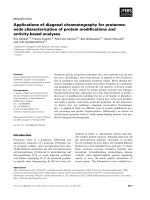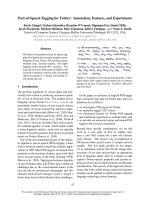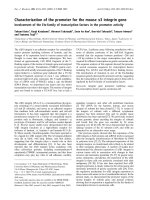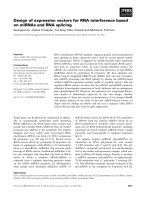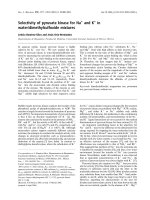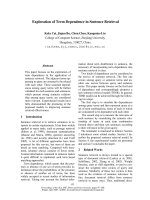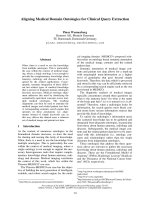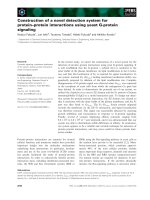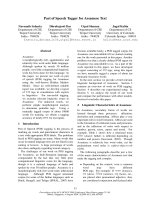Báo cáo khoa học: "Construction of Domain Dictionary for Fundamental Vocabulary" pdf
Bạn đang xem bản rút gọn của tài liệu. Xem và tải ngay bản đầy đủ của tài liệu tại đây (132.91 KB, 4 trang )
Proceedings of the ACL 2007 Demo and Poster Sessions, pages 137–140,
Prague, June 2007.
c
2007 Association for Computational Linguistics
Construction of Domain Dictionary for Fundamental Vocabulary
Chikara Hashimoto
Faculty of Engineering,
Yamagata University
4-3-16 Jonan, Yonezawa-shi, Yamagata,
992-8510 Japan
Sadao Kurohashi
Graduate School of Informatics,
Kyoto University
36-1 Yoshida-Honmachi, Sakyo-ku, Kyoto,
606-8501 Japan
Abstract
For natural language understanding, it is es-
sential to reveal semantic relations between
words. To date, only the IS-A relation
has been publicly available. Toward deeper
natural language understanding, we semi-
automatically constructed the domain dic-
tionary that represents the domain relation
between Japanese fundamental words. This
is the first Japanese domain resource that is
fully available. Besides, our method does
not require a document collection, which is
indispensable for keyword extraction tech-
niques but is hard to obtain. As a task-based
evaluation, we performed blog categoriza-
tion. Also, we developed a technique for es-
timating the domain of unknown words.
1 Introduction
We constructed a lexical resource that represents the
domain relation among Japanese fundamental words
(JFWs), and we call it the domain dictionary.
1
It
associates JFWs with domains in which they are typ-
ically used. For example,
home run is
associated with the domain SPORTS
2
. That is, we
aim to make explicit the horizontal relation between
words, the domain relation, while thesauri indicate
the vertical relation called IS-A.
3
1
In fact, there have been a few domain resources in Japanese
like Yoshimoto et al. (1997). But they are not publicly available.
2
Domains are CAPITALIZED in this paper.
3
The lack of the horizontal relationship is also known as the
“tennis problem” (Fellbaum, 1998, p.10).
2 Two Issues
You have to address two issues. One is what do-
mains to assume, and the other is how to associate
words with domains without document collections.
The former is paraphrased as how people cate-
gorize the real world, which is really a hard prob-
lem. In this study, we avoid being too involved in
the problem and adopt a simple domain system that
most people can agree on, which is as follows:
CULTURE
RECREATION
SPORTS
HEALTH
LIVING
DIET
TRANSPORTATION
EDUCATION
SCIENCE
BUSINESS
MEDIA
GOVERNMENT
It has been created based on web directories such
as Open Directory Project with some adjustments.
In addition, NODOMAIN was prepared for those
words that do not belong to any particular domain.
As for the latter issue, you might use keyword ex-
traction techniques; identifying words that represent
a domain from the document collection using statis-
tical measures like TF*IDF and matching between
extracted words and JFWs. However, you will find
that document collections of common domains such
as those assumed here are hard to obtain.
4
Hence,
we had to develop a method that does not require
document collections. The next section details it.
4
Initially, we tried collecting web pages in Yahoo! JAPAN.
However, we found that most of them were index pages with a
few text contents, from which you cannot extract reliable key-
words. Though we further tried following links in those index
pages to acquire enough texts, extracted words turned out to be
site-specific rather than domain-specific since many pages were
collected from a particular web site.
137
Table 1: Examples of Keywords for each Domain
Domain Examples of Keywords
CULTURE movie, music
RECREATION tourism, firework
SPORTS player, baseball
HEALTH surgery, diagnosis
LIVING childcare, furniture
DIET chopsticks, lunch
TRANSPORTATION
station, road
EDUCATION teacher, arithmetic
SCIENCE research, theory
BUSINESS import, market
MEDIA broadcast, reporter
GOVERNMENT judicatory, tax
3 Domain Dictionary Construction
To identify which domain a JFW is associated with,
we use manually-prepared keywords for each do-
main rather than document collections. The con-
struction process is as follows: 1 Preparing key-
words for each domain (§3.1). 2 Associating JFWs
with domains (§3.2). 3 Reassociating JFWs with
NODOMAIN (§3.3). 4 Manual correction (§3.5).
3.1 Preparing Keywords for each Domain
About 20 keywords for each domain were collected
manually from words that appear most frequently in
the Web. Table 1 shows examples of the keywords.
3.2 Associating JFWs with Domains
A JFW is associated with a domain of the highest
A
d
score. An A
d
score of domain is calculated by
summing up the top five A
k
scores of the domain.
Then, an A
k
score, which is defined between a JFW
and a keyword of a domain, is a measure that shows
how strongly the JFW and the keyword are related
(Figure 1). Assuming that two words are related
if they cooccur more often than chance in a cor-
pus, we adopt the χ
2
statistics to calculate an A
k
score and use web pages as a corpus. The number
of co-occurrences is approximated by the number of
search engine hits when the two words are used as
queries. Among various alternatives, the combina-
tion of the χ
2
statistics and web pages is adopted
following Sasaki et al. (2006).
Based on Sasaki et al. (2006), A
k
score between
JFWs JFW
1
JFW
2
JFW
3
· · ·
DOMAIN
1
kw
1a
kw
1b
· · ·
DOMAIN
2
kw
2a
kw
2b
· · ·
· · ·
A
d
score
JFW
m
kw
na
kw
nb
· · ·
DOMAIN
n
A
k
scores
Figure 1: Associating JFWs with Domains
a JFW (jw) and a keyword (kw) is given as below.
A
k
(jw, kw) =
n(ad − bc)
2
(a + b)(c + d)(a + c)(b + d)
where n is the total number of Japanese web pages,
a = hits(jw & kw), b = hits(jw) − a,
c = hits(kw) − a, d = n − (a + b + c).
Note that hits(q) represents the number of search
engine hits when q is used as a query.
3.3 Reassociating JFWs with NODOMAIN
JFWs that do not belong to any particular domain,
i.e. whose highest A
d
score is low should be re-
associated with NODOMAIN. Thus, a threshold for
determining if a JFW’s highest A
d
score is low
is required. The threshold for a JFW (jw) needs
to be changed according to hits(jw); the greater
hits(jw) is, the higher the threshold should be.
To establish a function that takes jw and returns
the appropriate threshold for it, the following semi-
automatic process is required after all JFWs are as-
sociated with domains: (i) Sort all tuples of the form
< jw, hits(jw), the highest A
d
of the jw > by
hits(jw).
5
(ii) Segment the tuples. (iii) For each
segment, extract manually tuples whose jw should
be associated with one of the 12 domains and those
whose jw should be deemed as NODOMAIN. Note
that the former tuples usually have higher A
d
scores
than the latter tuples. (iv) For each segment, identify
a threshold that distinguishes between the former tu-
ples and the latter tuples by their A
d
scores. At this
point, pairs of the number of hits (represented by
each segment) and the appropriate threshold for it
are obtained. (v) Approximate the relation between
5
Note that we acquire the number of search engine hits and
the A
d
score for each jw in the process
2 .
138
the number of hits and its threshold by a linear func-
tion using least-square method. Finally, this func-
tion indicates the appropriate threshold for each jw.
3.4 Performance of the Proposed Method
We applied the method to JFWs installed on JU-
MAN (Kurohashi et al., 1994), which are 26,658
words consisting of commonly used nouns and
verbs. As an evaluation, we sampled 380 pairs of
a JFW and its domain, and measured accuracy.
6
As
a result, the proposed method attained the accuracy
of 81.3% (309/380).
3.5 Manual Correction
Our policy is that simpler is better. Thus, as one
of our guidelines for manual correction, we avoid
associating a JFW with multiple domains as far as
possible. JFWs to associate with multiple domains
are restricted to those that are EQUALLY relevant to
more than one domain.
4 Blog Categorization
As a task-based evaluation, we categorized blog ar-
ticles into the domains assumed here.
4.1 Categorization Method
(i) Extract JFWs from the article. (ii) Classify the
extracted JFWs into the domains using the domain
dictionary. (iii) Sort the domains by the number of
JFWs classified in descending order. (iv) Categorize
the article as the top domain. If the top domain is
NODOMAIN, the article is categorized as the second
domain under the condition below.
|W (2ND DOMAIN)| ÷ |W (NODOMAIN)| > 0.03
where |W (D)| is the number of JFWs classified into
the domain D.
4.2 Data
We prepared two blog collections; B
controlled
and
B
random
. As B
controlled
, 39 blog articles were
collected (3 articles for each domain including
NODOMAIN) by the following procedure: (i) Query
the Web using a keyword of the domain.
7
(ii) From
6
In the evaluation, one of the authors judged the correctness
of each pair.
7
To collect articles that are categorized as NODOMAIN, we
used
diary as a query.
Table 2: Breakdown of B
random
Domain #
CULTURE 4
RECREATION 1
SPORTS 3
HEALTH 1
Domain #
DIET 4
BUSINESS 12
NODOMAIN 5
the top of the search result, collect 3 articles that
meet the following conditions; there are enough text
contents in it, and people can confidently make a
judgment about which domain it is categorized as.
As B
random
, 30 articles were randomly sampled
from the Web. Table 2 shows its breakdown.
Note that we manually removed peripheral con-
tents like author profiles or banner advertisements
from the articles in both B
controlled
and B
random
.
4.3 Result
We measured the accuracy of blog categorization.
As a result, the accuracy of 89.7% (35/39) was at-
tained in categorizing B
controlled
, while B
random
was categorized with 76.6% (23/30) accuracy.
5 Domain Estimation for Unknown Words
We developed an automatic way of estimating the
domain of unknown word (uw) using the dictionary.
5.1 Estimation Method
(i) Search the Web by using uw as a query. (ii) Re-
trieve the top 30 documents of the search result. (iii)
Categorize the documents as one of the domains by
the method described in §4.1. (iv) Sort the domains
by the number of documents in descending order.
(v) Associate uw with the top domain.
5.2 Experimental Condition
(i) Select 10 words from the domain dictionary for
each domain. (ii) For each word, estimate its domain
by the method in §5.1 after removing the word from
the dictionary so that the word is unknown.
5.3 Result
Table 3 shows the number of correctly domain-
estimated words (out of 10) for each domain.
Accordingly, the total accuracy is 67.5% (81/120).
139
Table 3: # of Correctly Domain-estimated Words
Domain #
CULTURE 7
RECREATION 4
SPORTS 9
HEALTH 9
LIVING 3
DIET 7
Domain #
TRANSPORTATION 7
EDUCATION 9
SCIENCE 6
BUSINESS 9
MEDIA 2
GOVERNMENT 9
As for the poor accuracy for RECREATION, LIV-
ING, and MEDIA, we found that it was due to either
the ambiguous nature of the words of domain or a
characteristic of the estimation method. The former
brought about the poor accuracy for MEDIA. That
is, some words of MEDIA are often used in other
contexts. For example,
live coverage is often
used in the SPORTS context. On the other hand, the
method worked poorly for RECREATION and LIV-
ING for the latter reason; the method exploits the
Web. Namely, some words of the domains, such as
tourism and shampoo, are often
used in the web sites of companies (BUSINESS) that
provide services or goods related to RECREATION
or LIVING. As a result, the method tends to wrongly
associate those words with BUSINESS.
6 Related Work
HowNet (Dong and Dong, 2006) and WordNet pro-
vide domain information for Chinese and English,
but there has been no domain resource for Japanese
that are publicly available.
8
Domain dictionary construction methods that
have been developed so far are all based on highly
structured lexical resources like LDOCE or Word-
Net (Guthrie et al., 1991; Agirre et al., 2001) and
hence not applicable to languages for which such
highly structured lexical resources are not available.
Accordingly, contributions of this study are
twofold: (i) We constructed the first Japanese
domain dictionary that is fully available. (ii)
We developed the domain dictionary construction
method that requires neither document collections
nor highly structured lexical resources.
8
Some human-oriented dictionaries provide domain infor-
mation. However, domains they cover are all technical ones
rather than common domains such as those assumed here.
7 Conclusion
Toward deeper natural language understanding, we
constructed the first Japanese domain dictionary that
contains 26,658 JFWs. Our method requires nei-
ther document collections nor structured lexical re-
sources. The domain dictionary can satisfactorily
classify blog articles into the 12 domains assumed in
this study. Also, the dictionary can reliably estimate
the domain of unknown words except for words that
are ambiguous in terms of domains and those that
appear frequently in web sites of companies.
Among our future work is to deal with domain in-
formation of multiword expressions. For example,
fount and collection constitute
tax deduction at source. Note that while itself
belongs to NODOMAIN, should be associ-
ated with GOVERNMENT.
Also, we will install the domain dictionary on JU-
MAN (Kurohashi et al., 1994) to make the domain
information fully and easily available.
References
Eneko Agirre, Olatz Ansa, David Martinez, and Ed Hovy.
2001. Enriching wordnet concepts with topic signa-
tures. In Proceedings of the SIGLEX Workshop on
“WordNet and Other Lexical Resources: Applications,
Extensions, and Customizations” in conjunction with
NAACL.
Zhendong Dong and Qiang Dong. 2006. HowNet And
the Computation of Meaning. World Scientific Pub Co
Inc.
Christiane Fellbaum. 1998. WordNet: An Electronic
Lexical Database. MIT Press.
Joe A. Guthrie, Louise Guthrie, Yorick Wilks, and Homa
Aidinejad. 1991. Subject-Dependent Co-Occurence
and Word Sense Disambiguation. In Proceedings of
the 29th Annual Meeting of the Association for Com-
putational Linguistics, pages 146–152.
Sadao Kurohashi, Toshihisa Nakamura, Yuji Matsumoto,
and Makoto Nagao. 1994. Improvements of Japanese
Mophological Analyzer JUMAN. In Proceedings of
the International Workshop on Sharable Natural Lan-
guage Resources, pages 22–28.
Yasuhiro Sasaki, Satoshi Sato, and Takehito Utsuro.
2006. Related Term Collection. Journal of Natural
Language Processing, 13(3):151–176. (in Japanese).
Yumiko Yoshimoto, Satoshi Kinoshita, and Miwako Shi-
mazu. 1997. Processing of proper nouns and use of
estimated subject area for web page translation. In
tmi97, pages 10–18, Santa Fe.
140
